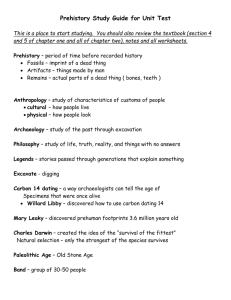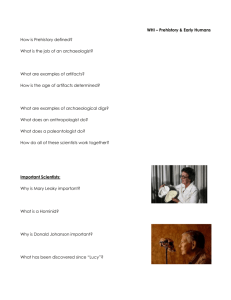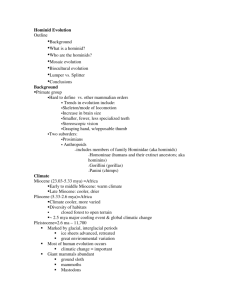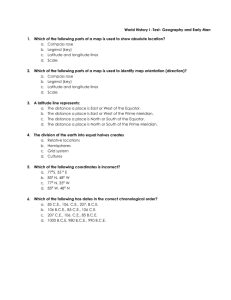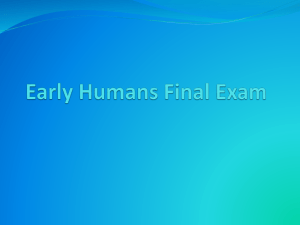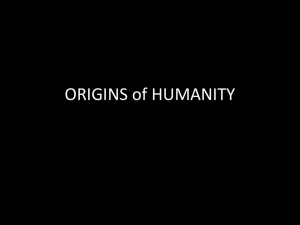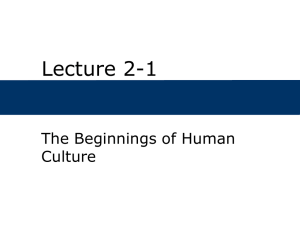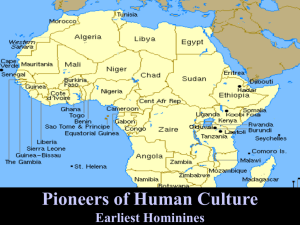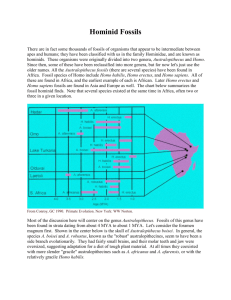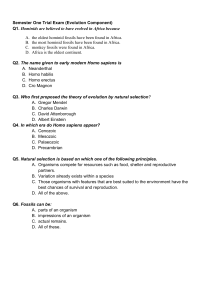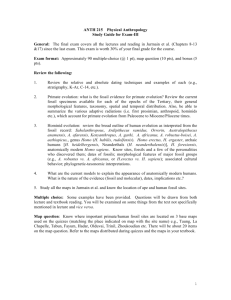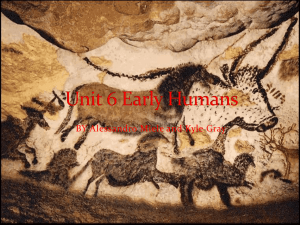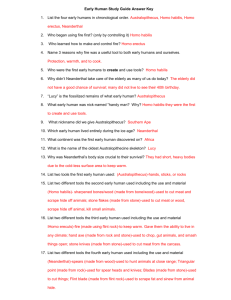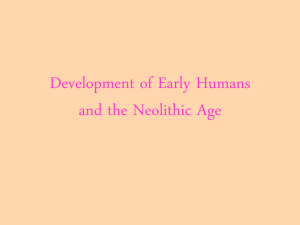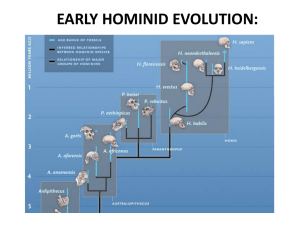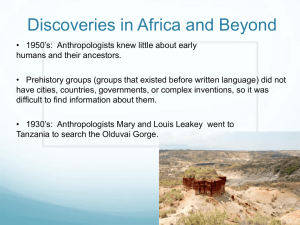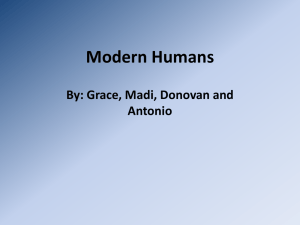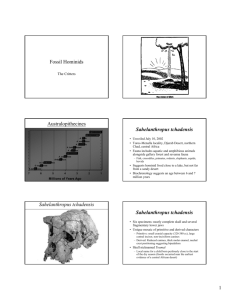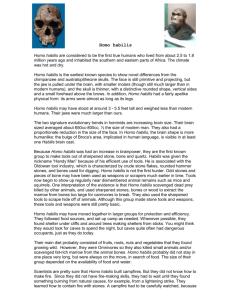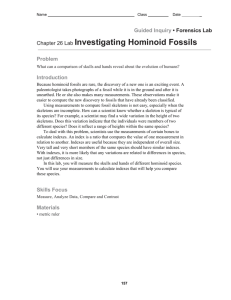參考文件1
advertisement
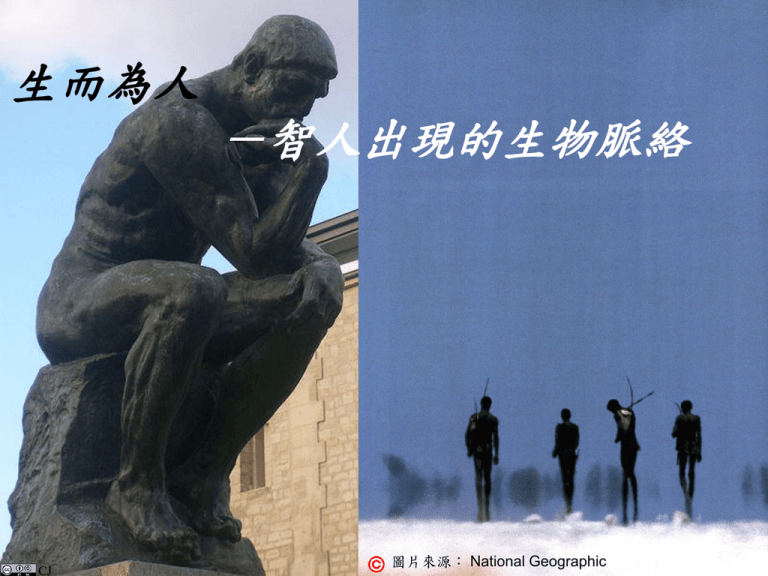
生而為人 -智人出現的生物脈絡 CJ 圖片來源: National Geographic 為什麼不是反向螺旋 為什麼不是三螺旋 存在就是合理 合理就是必然? 核酸三螺旋 The base pairing / Flicker: ynse The double helix David Hall 為什麼人類會在這塊特殊的土地上 為什麼人類會在這塊特殊的土地上 以一種理性為本的態度思考問題 以一種理性為本的態度思考問題 Flicker: Michal Osmenda Who are we? 人是萬物之靈? What can we do? 人定勝天? Jane Goodal kafka4prez An elephant struggling to help another get back on its feet as it lays dying from a snake bite is proof that wild animals have feelings too. And as her lifeless body lay on the dusty ground the next day, other grief-striken elephants gathered round to mourn, either standing silently or rocking back and forth, heart-broken. It is proof that elephants, in many ways, think like humans, feel like humans and act like humans. Where most animals, unlike humans, appear to show little interest in the dead of their own species - apart a handful of other animals such as chimpanzees and dolphins for example these elephants are concerned about their ailing or dead members of their species. 圖片來源: http://www.dailymail.co.uk/news/article-400522/Proof-elephants-compassion-face-death.html 類出如 有來果 文的文 化習化 嗎性是 ?,後 只天 有發 人展 Some groups of chimpanzees are known to crack hard-shelled nuts with the help of hammers and anvils made of stone. Chimpanzee infants look carefully at the actions of their mothers and may interfere with her nut cracking actions. Mothers seem to actively transfer knowledge to their dependent offspring through stimulation and facilitation Boesch 1991 圖片來源:http://www.intercult.su.se/~carladam/Research.html 人類的演化 Who are we? What can we do? Where are we going? Manuel Cernuda 古猿階段 1,200萬年前形成東非大裂谷,這個天然屏障是人和猿分 道揚鑣的關鍵,裂谷西方依然是茂密的濕潤的樹叢, 不需 作出太大的改變來協調。裂谷以東的由於降雨量漸次減 少,林地消失出現了草原,大部分猿類祖先族群因而滅絕, 其中一小部分猿類適應了新環境,學習在地上活動。 智人 尼安德塔人 直立人 非洲直立人 http://www.ngensis.com/human.htm 人科 Family: Hominidae 古猿屬 Genus: Australopithecus 南方古猿 Australopithecus afarensis (3.6百萬年~2.9百萬年前) Reed DL, Smith VS, Hammond SL, Rogers AR, Clayton DH 非洲南方古猿 Australopithecus africanus (3百萬年~ 2百萬年前) 粗壯南方古猿 Australopithecus robustus (3百萬年~2百萬年前) 鮑氏南方古猿 Australopithecus boisei (2.3百萬年~1.4百萬年前) 人屬 Genus: Homo 能人 Homo habilis (2.3百萬年~1.6百萬年前) 直立人 Homo erectus (1.8百萬年~30萬年前) 海德堡人 Homo heidelbergensis (60萬年~10萬年前) 尼安德特人 Homo neanderthalensis (25萬年~3萬年前) 智人(現代人) Homo sapiens (10萬年~現代) 人屬演化樹 古猿階段 約600萬年前,孕育了一類大型的,勉強 以雙足著地,雙手作輔助的靈長類動物, 被稱為古猿,祗分布於非洲大陸的南部, 故名為南方古猿(Australopithecus)。 現時所知最早的南方古猿 (Australopithecus afarensis),其出現年代少 於600萬~300萬年, 這個物種腦容量很 小, 雄性明顯遠比雌性為大。 Lucy 被稱為“露西”(Lucy)的年輕雌性南方古猿骸骨 於1974年在依索比亞出土, 由於骨骼較為完整, 使 人能確立古猿的行走形式: 以足直立, 步履蹣跚, 科 學家從肩胛骨及臂骨分析發現: 南方古猿仍保持靈 長類遠祖的攀援的特徵 。之後發現的非洲南方古 猿(Australopithecus africanus), 推測其身高為145厘米 , 雄性平均體重為65千克, 雌性35千克 , 腦容量為 現代人的三分之一。 南方古猿屬 Australopithecus aethiopicus Commonly referred to as the "Black Skull," due to its blue-black color, it was discovered in 1985 on the west shore of LakeTurkana in northern Kenya. Although not considered a direct line to humans, it is a prime example of ancient hominid evolution. Latest dating techniques place it somewhere between A. afarensis and A. boisei. Nrkpan Australopithecus habilis was discovered by Peter Nzube in 1968. This nearly complete, but very badly crushed specimen, constituted the oldest hominid found in Olduvai Gorge, Tanzania. derivative work: Sargoth /Photographed by User:Lillyundfreya http://www.evolutionnyc.com 粗壯南猿 2.1-1.6 Million years ago 鮑氏南猿 Nrkpan Guérin Nicolas 巧人 腦容量 590~650 cc Homo habilis ("handy man", "skillful person") is a species of the genus Homo, which lived from approximately 2.5 million to 1.8 million years ago at the beginning of the Pleistocene. derivative work: Sargoth /Photographed by User:Lillyundfreya 物質文明的歷史 —黎明之前 250萬年前非洲巧人 用的砍器、刮刀及鎚石 1.8 to 1.5 million years ago Homo ergaster This hominid was possibly a descendent of Homo habilis and lived at the same time as some australopithecines. Turkana Boy was between 8 and 11 years old-scientists can tell from his teeth. Judging by the shape of his pelvis and the size of other bones, he was male. Claire Houck 直立人(Homo erectus )階段 [200~20萬年前] Joop anker 爪哇猿人頭蓋骨 1891年荷蘭人杜步哇(Eugene Dubois) 在印尼爪哇島發現了一個 頭蓋骨及牙齒,之後的兩三年期間,他 發現股骨和臼齒, 從股骨分析該類人 科動物顯然能直立行走命名為瓜哇 直立猿人 (Homo erectus)。 1927年在中國北京周口店發現了幾 枚牙齒,定名為”北京中國猿人”, 或稱” 北京人”,1929年12月2日在同地點發 現了第一個較完整的頭蓋骨,震盪了 整個人類學界。 1920~1930年之間相繼發現了更多 kevinzim 的頭蓋骨、肢骨、下顎骨等。北京 北京人頭骨復原圖 人的發現更一步印證了哇爪猿人的 可靠性,它們皆為直立人的成員。 Photographed by User:Lillyundfreya Frank Vincentz 直立人復原圖 早期(25萬年~4萬年前)智人 最原始的智人為尼安德塔人(Homo neanderthalensis) 1856年最早發現於德國的尼安德塔河流域的一個山洞而 得名。就腦容量而言,超越1300毫升的紀錄,甚至大於 現代人。其他骨骼和現代人已十分相似。 尼人多在洞穴中發現, 伴以大量的精巧的石器製品、 薄石片、骨針 、動物化石和用火痕跡等, 他們可能開始 穴居或半穴居生活, 以火取暖和以火驅逐野獸, 能用獸 皮製衣蔽體等, 尼人發明了葬儀, 年長的成員會將生活 經驗傳授後代。 現代人(左)與 尼安德特人(右) 額骨對比 尼安德塔人復原圖 在法國 Chauvet Pont-d’Arc 洞窟中, 兩萬年前的先民在穴壁上繪製草原上奔馳的獸群之美。 Peter80 Prof saxx Peter80 人屬的優勢 當今的人類是人屬的一員,經直立人和早期智人進化而來。為什麼 只有早期的人屬成員發展出現代人,而當時的各種南方古猿卻沒有 繼續發展而走向絕滅?人屬擁有什麼競爭優勢呢? 腦量的飛躍 現代人 獨特的生長曲線 軟弱無助的嬰兒期 黑猩猩 童年時代的延長 社會結構的重要改變 肉食性增強 運動方式上有更強適應力 會製造工具 猩猩 獼猴 智人的優勢 Christopher Walsh, Harvard Medical School ◎使用語言和發展了文字 ◎集體勞動、集體生活的需要畜牧及農業的產生 ◎文化還是遺傳 人種有多不同? superkas83 andrewasmith Cliff1066 Keith Allison GeoJono Kiltbear Luc legay 阿茲海默症 (Alzheimer,愛的折磨) 是主要的失智症,會使腦幹、海馬迴區受損, 失去神經元,腦部皺折變平滑(左圖) ,右圖是 正常的腦。 Ultimate Human Frontier See through mind & with mind Jan Ainali 人類能看多遠? 人類能看多遠? 人類對自己與週遭世界的認知 與其他生物有什麼差別? 當遺傳已走到盡頭 文化仍方興未艾 Ai@ce 參考資料 • • • • • http://www.nationalgeographic.com/ http://www.dailymail.co.uk/news/article-400522/Proof-elephantscompassion-face-death.html http://www.dailymail.co.uk/legacygallery/gallery-8482/How-elephantscompassion-face-death.html?selectedImage=74656 http://www.intercult.su.se/~carladam/Research.html http://www.ngensis.com/human.htm http://www.micro.utexas.edu/courses/levin/bio304/humanevol/humanevol.ht ml
